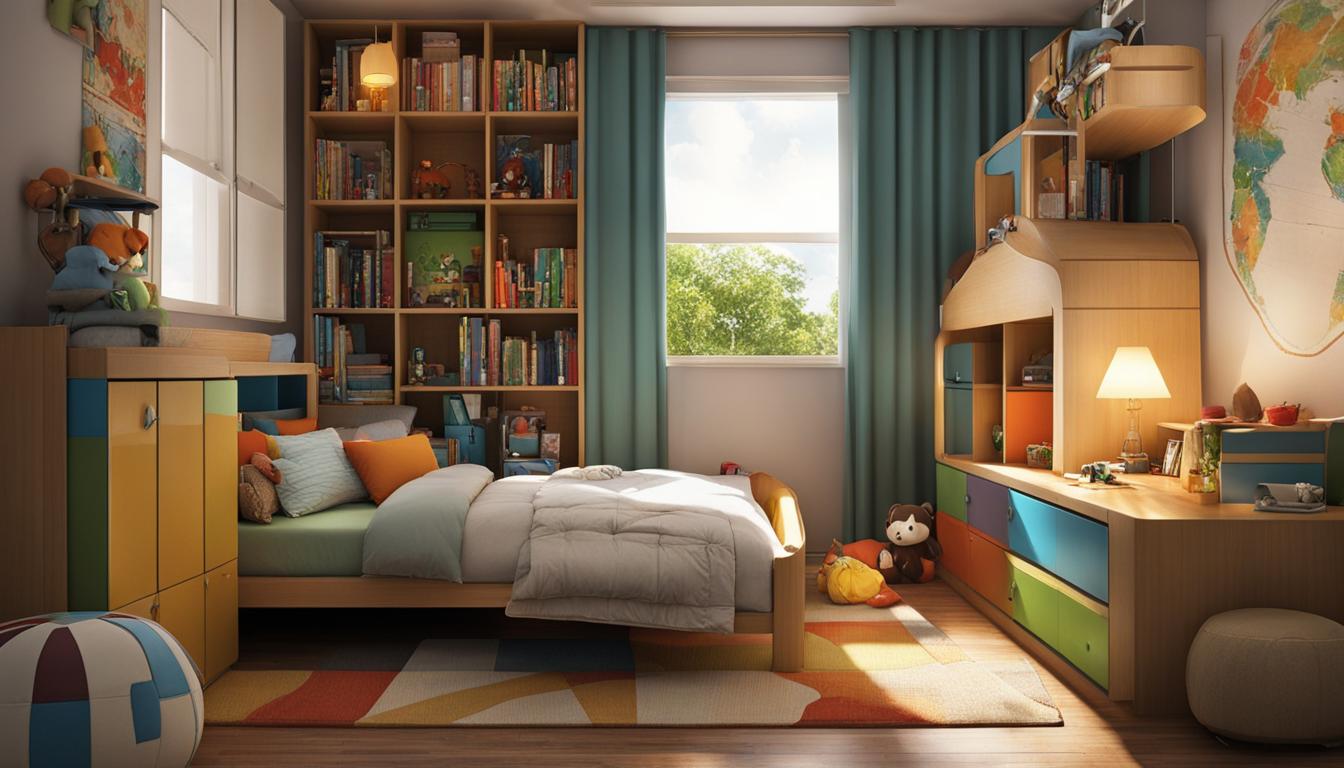Transition Bed and Nighttime Fears: Easing Anxiety for a Peaceful Sleep!
Transitioning from a crib to a big kid bed can be an exciting milestone for your toddler. However, it can also bring about nighttime fears and anxiety, making it difficult for your little one to have a peaceful sleep. As a parent, it’s essential to understand these common fears and learn strategies to help your child overcome them, ensuring a smooth transition and restful nights.
One common fear that many children face during this transition is being scared of the dark. The new environment of a big kid bed can feel unfamiliar and intimidating, especially in the absence of the familiar nightlight from their crib. Additionally, the idea of sleeping alone without the comfort of their parents nearby can also create anxiety.
But fret not! There are several ways to ease your child’s fears and create a soothing bedtime routine that promotes better sleep. By implementing these strategies, you can help your child feel secure and confident in their new bed, leading to more restful nights for everyone in the family.
Key Takeaways:
- Transitioning from a crib to a big kid bed can bring about nighttime fears and anxiety in children.
- Common fears include being scared of the dark and sleeping alone.
- Understanding these fears is crucial to effectively address your child’s anxiety.
- Implementing a consistent and calming bedtime routine can help your child feel secure and promote better sleep.
- There are various relaxation techniques and natural products that can aid in easing anxiety and promoting a peaceful sleep environment.
Understanding Nighttime Anxiety in Children

Nighttime anxiety can manifest in different ways for each child. It’s crucial for parents to recognize the symptoms and implement strategies to help their children manage their anxiety and improve their sleep quality. Here are some common symptoms of nighttime anxiety in children:
- Trouble falling and staying asleep
- Trouble concentrating
- Feelings of restlessness and nervousness
- Gastrointestinal problems
- Nightmares and night terrors
- Panic attacks
Each child may experience a combination of these symptoms or exhibit unique signs of nighttime anxiety. By understanding these symptoms, parents can take proactive steps to address their child’s anxiety and create a more peaceful bedtime routine.
“Nighttime anxiety can greatly disrupt a child’s sleep, which can affect their overall well-being and development. It’s essential for parents to provide support and implement effective strategies to help their children overcome bedtime anxiety and get the restful sleep they need.” – Dr. Emily Wilson, Child Psychologist
Implementing a bedtime routine for anxious children can significantly help manage nighttime fears. The next section will discuss practical strategies that parents can incorporate into their child’s routine to ease anxiety and promote better sleep.
Creating a Calming Bedtime Routine

Transitioning from a crib to a bed can be an exciting milestone for your child. However, it can also be accompanied by fears and anxieties that can disrupt their sleep. By establishing a consistent and calming bedtime routine, you can help your child transition with confidence and promote better sleep.
Here are some key elements to include in your child’s bedtime routine:
- Limited Screen Time: Encourage your child to wind down by limiting screen time before bed. The blue light emitted by screens can interfere with their natural sleep-wake cycle.
- Avoid Heavy Meals and Caffeine: Make sure your child avoids heavy meals and caffeine close to bedtime. These can disrupt their digestion and keep them awake.
- Exposure to Natural Sunlight: During the day, encourage your child to spend time outdoors and get exposure to natural sunlight. This helps regulate their internal clock and promotes better sleep at night.
- Dark and Cool Bedroom: Create a sleep-friendly environment by ensuring the bedroom is dark, cool, and quiet. Consider using blackout curtains or a nightlight if your child is afraid of the dark.
- Relaxation Exercises: Engage in relaxation exercises like meditation or diaphragmatic breathing to help calm your child’s anxiety before bed. These practices can promote a sense of peace and relaxation.
By incorporating these elements into your child’s bedtime routine, you can create a calming and soothing environment that promotes better sleep. Remember, consistency is key in helping your child feel secure and confident during this transition.
Managing Anxiety Through Transition Rituals

Transition rituals can play a crucial role in helping both children and adults wind down and transition from the demands of the day to a state of relaxation before sleep. These rituals create a buffer zone between work and sleep, allowing individuals to set themselves up for a better rest. By incorporating activities that wind you down and get you in the mood for sleep, you can effectively calm pre-bedtime anxiety and leave work and technology behind.
Here are some effective transition rituals to consider:
- Dim the Lights: Lower the brightness in your bedroom and create a cozy and soothing atmosphere.
- Calming Music: Listen to soft and relaxing tunes that promote a sense of tranquility.
- Take a Warm Bath: Indulge in a warm bath to release tension and prepare your body for sleep.
- Journaling: Express your anxious feelings by writing them down in a journal. This practice can help you process your emotions and alleviate anxiety.
- Stream-of-Consciousness Writing: Engage in stream-of-consciousness writing to ease anxiety. Let your thoughts flow freely on paper without judgment or filter.
By integrating these transition rituals into your nightly routine, you can create a conducive environment for relaxation and improve your chances of experiencing a restful sleep.
Remember, it’s important to leave work and technology behind as you engage in these rituals. Allow yourself to disconnect from the demands of the day and focus on winding down. A peaceful transition to sleep will help calm your pre-bedtime anxiety and set the stage for a rejuvenating night of rest.
Take the Time to Unwind and Relax
“Transition rituals are like a gentle lullaby for your mind and body, helping you release the stress of the day and prepare for a peaceful sleep.” – Sleep Experts
Stimulus Control Techniques for Better Sleep
Creating a sleep-friendly environment is essential for promoting relaxation and quality sleep. By implementing stimulus control techniques, you can enhance your sleep environment and reduce nighttime anxiety. Here are a few strategies to consider:
Avoid Bright Screens Before Bed
Exposure to bright screens, such as smartphones and tablets, before bedtime can disrupt your sleep-wake cycle. The blue light emitted by these devices can suppress the production of melatonin, a hormone that regulates sleep. To avoid this, make it a habit to avoid bright screens at least one hour before bed. Instead, engage in relaxing activities like reading a book or listening to soft music.
Control Light and Sound Levels
Creating a dark and peaceful bedroom environment can significantly impact your sleep quality. Invest in blackout curtains or shades to block out external sources of light. Consider using a sleep mask if complete darkness is not achievable. Additionally, using white noise machines or earplugs can help mask disruptive sounds, allowing for a more restful sleep.
Maintain Optimal Bedroom Temperature
The temperature in your bedroom plays a crucial role in sleep quality. Research suggests that the ideal bedroom temperature for most people falls between 60 and 67 degrees Fahrenheit (15-19 degrees Celsius). Experiment with different temperature settings to find the one that promotes your comfort and enhances sleep efficiency.
“Creating a sleep-friendly environment is essential for promoting relaxation and quality sleep.”
By incorporating these stimulus control techniques into your nighttime routine, you can create an environment that is conducive to better sleep. Remember, small adjustments can make a big difference. So, prioritize avoiding bright screens before bed, controlling light and sound levels, and maintaining an optimal bedroom temperature to reduce nighttime anxiety and achieve a more restful sleep.
| Stimulus Control Techniques for Better Sleep |
|---|
| Avoid bright screens before bed |
| Use blue light filters on electronic devices |
| Control light and sound levels in the bedroom |
| Maintain a cool temperature between 60 to 67 degrees Fahrenheit |
Natural Products for Relaxation and Sleep Support

When it comes to promoting relaxation and supporting better sleep, there are a variety of natural products that can make a difference. Weighted blankets, sound machines and nightlights, and calming pre-sleep snacks are just a few examples of these products that can help create a more soothing sleep environment.
| Product | Description |
|---|---|
| Weighted Blankets | Weighted blankets provide a calming and grounding effect, simulating the feeling of a gentle hug. The added weight can help reduce anxiety and promote a sense of security, making it easier to fall asleep and stay asleep throughout the night. |
| Sound Machines and Nightlights | Sound machines can create a peaceful atmosphere by playing soothing sounds, such as nature sounds or white noise, that help block out disturbing noises and promote relaxation. Nightlights provide a gentle, dim light that can help ease fears of the dark and create a cozy sleep environment. |
| Calming Pre-Sleep Snacks | Choosing the right bedtime snack can have a positive impact on sleep. Certain foods, like tart cherries, chamomile tea, and Brazil nuts, have sleep-inducing properties and can help reduce anxiety. Including these snacks in your evening routine can help prepare your body and mind for a restful night’s sleep. |
By incorporating these natural products into your sleep routine, you can create a peaceful and relaxing environment that promotes better sleep. Whether it’s the comforting weight of a weighted blanket, the soothing sounds from a sound machine, or the calming effects of sleep-inducing snacks, these products can help you unwind and prepare for a restful night’s sleep.
Breathing Techniques and Meditation for Anxiety Relief
Breathing exercises and meditation are powerful tools for managing anxiety and promoting better sleep. Incorporating these practices into your nightly routine can help reduce anxiety and improve your sleep quality.
One effective breathing technique for anxiety relief is the 4-7-8 method. It involves inhaling through your nose for a count of 4, holding your breath for a count of 7, and then exhaling through your mouth for a count of 8. This technique helps slow down your breathing, sending signals to your brain and body that it’s time to relax.
Meditation is another effective practice for calming the mind and reducing anxiety. Whether you prefer silent sitting or guided meditation, taking a few minutes each day to quiet your thoughts can have a profound impact on your mental well-being. Meditation before bedtime can be especially beneficial in helping you navigate the stress of the day and prepare for a restful night of sleep.
Remember, finding the right breathing technique and meditation practice may take some trial and error. Be patient with yourself as you explore different methods and techniques. Consistency is key, so try to incorporate these practices into your nightly routine for optimal results.
Summary of Breathing Exercises and Meditation Techniques
| Breathing Technique | Meditation Technique |
|---|---|
| 4-7-8 breathing method | Silent sitting |
| Diaphragmatic breathing | Guided meditation |
| Alternate nostril breathing | Mindfulness meditation |
Conclusion
Transitioning from a crib to a bed can be a challenging time for children, as they may experience nighttime fears and anxiety. However, by understanding the common fears and symptoms associated with nighttime anxiety, implementing a calming bedtime routine, managing external stimuli, and utilizing relaxation techniques, you can help ease your child’s anxiety and promote a peaceful sleep.
It’s important to recognize that managing nighttime anxiety may take time and patience. By consistently implementing strategies such as establishing a calming bedtime routine, controlling external stimuli like light and sound, and incorporating relaxation techniques like breathing exercises or meditation, you can create a conducive environment for better sleep.
If your child’s nighttime anxiety persists and significantly affects their overall well-being, it’s important to seek professional help. Consulting with a healthcare provider or a sleep specialist can provide additional guidance and support tailored to your child’s specific needs.
Remember, with your dedication and the implementation of these strategies, your child can overcome their nighttime fears and achieve restful nights of sleep. By managing anxiety during the transition from a crib to a bed, you can provide your child with the comfort and security they need for a peaceful sleep experience.
FAQ
What are some common nighttime fears that children may have during the transition from a crib to a big kid bed?
Some common nighttime fears during this transition include being scared of the dark, sleeping alone, and experiencing anxiety about the new sleeping arrangement.
How can I help my child overcome their fear of sleeping alone?
You can help your child overcome their fear of sleeping alone by gradually transitioning them to their new bed, providing reassurance and comfort, and creating a calming bedtime routine that promotes relaxation.
What strategies can I use to manage my child’s nighttime anxiety?
Strategies for managing nighttime anxiety in children include establishing a consistent bedtime routine, limiting screen time before bed, creating a dark and cool bedroom environment, and engaging in relaxation exercises like meditation or deep breathing.
What can I include in a calming bedtime routine for my child?
A calming bedtime routine can include activities such as dimming the lights, listening to calming music, taking a warm bath, journaling to express anxious feelings, and practicing relaxation techniques like deep breathing.
How can I control external stimuli to promote better sleep for my child?
You can control external stimuli by avoiding bright screens before bed, using blue light filters on electronic devices, maintaining a cool temperature in the bedroom, and using sound machines or nightlights to create a soothing sleep environment.
Are there any natural products that can help promote relaxation and better sleep for my child?
Yes, there are natural products such as weighted blankets, sound machines, and nightlights that can help promote relaxation and improve sleep quality for children.
What breathing techniques and meditation exercises can help manage anxiety and promote better sleep?
Breathing techniques like the 4-7-8 method can help relax the body and mind before bedtime. Meditation practices, whether in the form of silent sitting or guided exercises, can quiet the mind and reduce anxiety.
How long does it typically take for a child to adjust to sleeping in a big kid bed?
The adjustment period for sleeping in a big kid bed can vary for each child. It may take a few weeks or even months for a child to fully adjust to this new sleeping arrangement.
When should I seek professional help if my child’s nighttime anxiety persists?
If your child’s nighttime anxiety persists and significantly impacts their overall well-being, it is advisable to seek professional help from a pediatrician or child psychologist who specializes in sleep disorders and anxiety.




